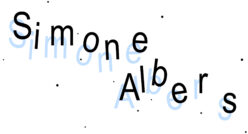Simone Albers (b. 1990, Nijmegen, NL) is a Dutch artist that works within the fields of painting, sculpture and installation art. She is interested in the more-than-human world and the way we relate to her. Albers’ practice revolves around examining this relationship by looking at underlying philosophical attitudes towards this world and how this is reflected in cultural and, specifically, scientific depictions of nature. Ontoepistimological questions on the nature of reality and the reach of our understanding continue to spark her curiosity. By interweaving philosophy, symbolism, cosmology and scientific insights and images, she puts together alternative representations of the more-than-human world that centralize the complexity of natural systems, rejecting reductionism and appropriation to ultimately challenge the anthropocentric worldview.

(Nijmegen, 1990) makes paintings and installations reflecting on the natural world and the way we relate to her. She is interested in how nature behaves on a fundamental level by looking for the mechanisms that lay hidden beyond the directly visible. For example by zooming in, looking at the forces, patterns and structures that play a role in certain processes or by searching for connections and interactions between objects.